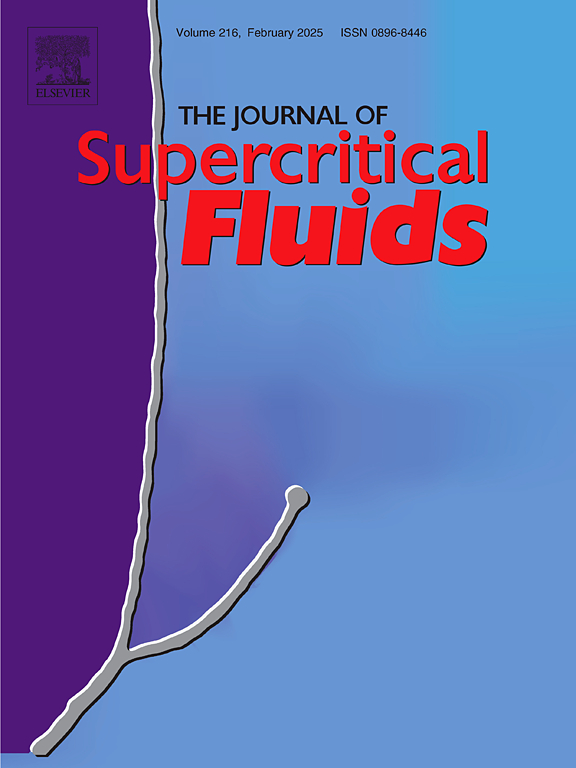Mixtures of supercritical CO2 + (1‑octanol and/or n‑alkanes) at saturation: Density and viscosity measurements
IF 4.4
3区 工程技术
Q2 CHEMISTRY, PHYSICAL
引用次数: 0
Abstract
Density and dynamic viscosity data were measured at phase transition for binary mixtures of CO2 with 1-octanol, n-dodecane and n-tetradecane, and ternary mixtures of CO2 with (1-octanol+n-dodecane), (1-octanol+n-tetradecane) and (n-dodecane+n-tetradecane). Data were measured at conditions between 308 and 348 K and up to 28 MPa and modelled using commercially available models in Aspen Plus® V11. A variable-volume high-pressure cell equipped with a torsional quartz crystal viscometer was used to detect the phase transition visually and non-visually. Densities were measured using the cell’s calibrated volume. The non-visual phase transition pressures compared well with the visual measurements (%AADP <3 %). The density and viscosity data for the CO2 +1-octanol exhibited an inversion, introducing a non-ideal, non-linear relationship between the physical properties and temperature. However, the addition of n-alkanes to the system removed these density and viscosity inversion effects. Further, the models poorly predicted the measured physical properties data, necessitating future improvements.
饱和状态下的超临界CO2 +(1 -辛醇和/或正烷烃)混合物:密度和粘度测量
测定了CO2与1-辛醇、正十二烷和正十四烷二元混合物以及CO2与(1-辛醇+正十二烷)、(1-辛醇+正十四烷)和(正十二烷+正十四烷)三元混合物的相变密度和动态粘度数据。在308至348 K和高达28 MPa的条件下测量数据,并使用Aspen Plus®V11中的市售模型进行建模。利用配备扭转石英晶体粘度计的变体积高压实验箱对相变进行了目测和非目测。密度测量使用细胞的校准体积。非目测相转变压力与目测相比较良好(%AADP <3 %)。CO2 +1-辛醇的密度和粘度数据出现了反转,引入了物理性质与温度之间的非理想非线性关系。然而,向体系中加入正构烷烃消除了这些密度和粘度反转效应。此外,这些模型对测量的物理性质数据预测得很差,需要进一步改进。
本文章由计算机程序翻译,如有差异,请以英文原文为准。
求助全文
约1分钟内获得全文
求助全文
来源期刊

Journal of Supercritical Fluids
工程技术-工程:化工
CiteScore
7.60
自引率
10.30%
发文量
236
审稿时长
56 days
期刊介绍:
The Journal of Supercritical Fluids is an international journal devoted to the fundamental and applied aspects of supercritical fluids and processes. Its aim is to provide a focused platform for academic and industrial researchers to report their findings and to have ready access to the advances in this rapidly growing field. Its coverage is multidisciplinary and includes both basic and applied topics.
Thermodynamics and phase equilibria, reaction kinetics and rate processes, thermal and transport properties, and all topics related to processing such as separations (extraction, fractionation, purification, chromatography) nucleation and impregnation are within the scope. Accounts of specific engineering applications such as those encountered in food, fuel, natural products, minerals, pharmaceuticals and polymer industries are included. Topics related to high pressure equipment design, analytical techniques, sensors, and process control methodologies are also within the scope of the journal.
 求助内容:
求助内容: 应助结果提醒方式:
应助结果提醒方式:


